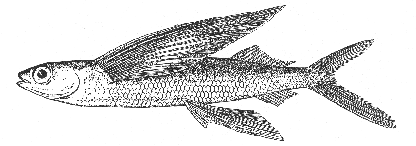Flying Fish Cypselurus heterurus (Rafinesque) 1810
[Jordan and Evermann, 1896-1900, p. 2836.]
Description—
Distinctive features of flying fishes of the genus Cypselurus, among its tribe, are pectoral fins so long that they overlap the anal fin considerably when laid back; ventrals standing far rearward and nearly or quite half as long as the pectorals; anal fin with its point of origin only a little forward of the mid-point of the base of the dorsal fin; and second ray of the pectoral fins branched. The species heterurus has a plain gray dorsal fin; it has no teeth on the palatine bone in the roof of its mouth; and the pale edging of the outer margin of its pectoral fins is extremely narrow. The number of its scales is distinctive, also, as is the number of its vertebrae. But these last two characters are matters for the specialist.
Color—
Dark blue gray on the back and on the upper part of the sides, silvery lower down on the sides, and below; the dorsal fin is plain gray, the rear margin of the pectorals with a very narrow pale edging.
Size—
The species heterurus is one of the larger flying fishes, commonly growing to a length of about 1 foot (to the base of the tail fin).
Occurrence in the Gulf of Maine—
A flying fish, about 9¼ inches long to the fork of the tail, seemingly of this species but not in good enough condition for certain identification, was taken in a trap of the Pond Village Cold Storage Co. at North Truro, on the Massachusetts Bay shore of Cape Cod, on August 4, 1952. This is the only record of one of its tribe, from our Gulf. And the only record of a flying fish from Nova Scotian coastal waters is by Jones, of one taken at Sable Island, in 1859.
Flying fishes are taken now and then at Woods Hole, the species heterurus perhaps more often than any other, according to published report, but several of the kinds to be expected in the Gulf Stream off our coast resemble one another very closely indeed. So we suggest that if a flying fish should be taken in our Gulf that does not seem to fit the accompanying illustration (fig. 83A) it be forwarded either to the Fisheries Laboratory of the U. S. Fish and Wildlife Service, Woods Hole, Massachusetts; to the Department of Fishes, U. S. National Museum, Washington, D. C.; or to the Department of Fishes, Museum of Comparative Zoology, Cambridge, Massachusetts, to be named.
